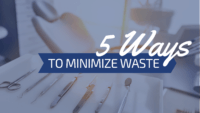 “Waste not, want not.”
“Waste not, want not.”
Such a simple idiom in theory, but not always so easy in practice. Here are some tips you can try in your office to help maximize the benefits your resources yield and cut down on the amount of waste you are generating over time.
Tip No. 1
Only give patients two bags of elastics. Each bag of our Galactic Elastics contains 100 individual elastics, so it would take quite a while for a patient to run through all of them. Many assistants simply grab a handful of baggies and give them to the patient. Even the most responsible patients who wear their elastics faithfully would be incapable of burning through 4 or 5 bags before their next appointment. Supplying your patient with two bags is perfectly reasonable and leaves plenty of room for special circumstances (patient’s parents live separately, patient wants to keep one bag at school and one at home, patient misplaces one bag, etc.).
Tip No. 2
Always start with less adhesive product than you think you will need. It can be difficult to judge how much of an adhesive product you will need, and sometimes it is even difficult to tell how much you are dispensing since the packaging must be dark. It is always nice to remind yourself that you can always dispense more of the product if you need it, but you can’t put it back in the bottle/syringe once you have already dispensed it. It is better to have to replenish your well multiple times than to get to the end of a procedure and find yourself discarding product.
Tip No. 3
We all know how crucial it is to maintain a dry field, but that doesn’t mean you have to generate a ton of waste to get the job done. Consider using a Nola dry field system as opposed to gauze and cotton rolls when bonding. This clever little device retracts the patients lips and cheeks to expose both arches in their entirety and attaches to your suction to eliminate all saliva. Unlike paper products, the Nola is sterilizable and can be reused from patient to patient. And as a bonus, it actually does a better job keeping the area dry! We offer the Nola Dry Field System in two different sizes, so you can use the device on patients of all ages!
Tip No. 4
Consider investing in intraoral mirrors! Many orthodontic providers use plastic disposable mirrors, and that is perfectly understandable. They are cheap, come in cute colors, and it’s easy to just toss them out instead of going through the process to clean them. Over time, however, this generates quite a lot of waste in plastic material and can also take a slow, but steady toll on your wallet. Plastic-handled mirrors often have a cheaper reflective surface, which means an unclear view for you. Also, you only get one single use out of them before they are discarded. Metal intraoral mirrors can be autoclaved and used for YEARS if you treat them with proper care, and the high-quality mirror material gives you a crisp view of every detail you need to see. Remind your staff to never place mirrors in the ultrasonic with other instruments. You’re basically asking for scratched mirrors if you do that. If they must be placed into the ultrasonic, ensure that mirrors are the only kind of instrument in the basket and do not place mirrors on top of each other. If any large debris remains, the mirrors can be gently hand-scrubbed with a soft sponge and water before they are placed in the autoclave. Take a look at the mirrors we carry at Five Star: Intraoral Mirrors
Tip No. 5
Finally, if there’s ANYTHING that NO ONE wants to waste…it’s time! As a dental care provider, you are already aware that time is one of your most valuable commodities. If you can find ways to cut down on any unnecessary waste of time in your practice, everyone will be happy! If you are sending your patient’s lab cases to us, we strongly recommend that you send a construction bite in with any appliance that requires occlusal coverage (twin block, sleep appliance, nightguard, etc.). Generally, that will eliminate a lot of adjustment time when delivering the appliance. It can also be useful to have your assistants go through the schedule in the morning and get each operatory “set” for the upcoming appointments. It can never hurt to have a few trays on standby with the basic instruments and supplies needed for a simple adjustment or single bracket replacement. This way, when one of your patients inevitably pops up for an emergency appointment, you can handle their “my wire is poking me” or “I ate a candy apple and now my bracket is missing” situation with no sweat on your part. Another time-saving trend that has taken off lately is Indirect Bonding for bracket placement. Thanks to this method, initial bonding appointments have never been simpler! The Indirect Bonding or “IDB” method drastically cuts down on chair time for your patient and lets you say “goodbye” to the tedious task of individually positioning each bracket. Check out our video to learn more about the process of indirect bonding and consider giving it a shot!